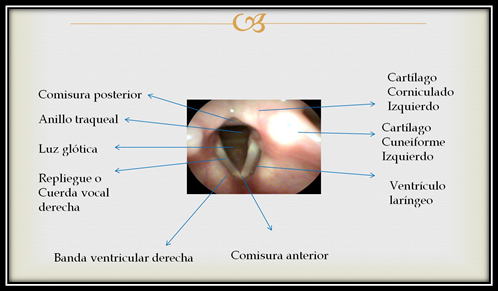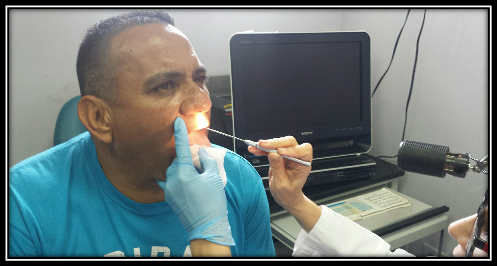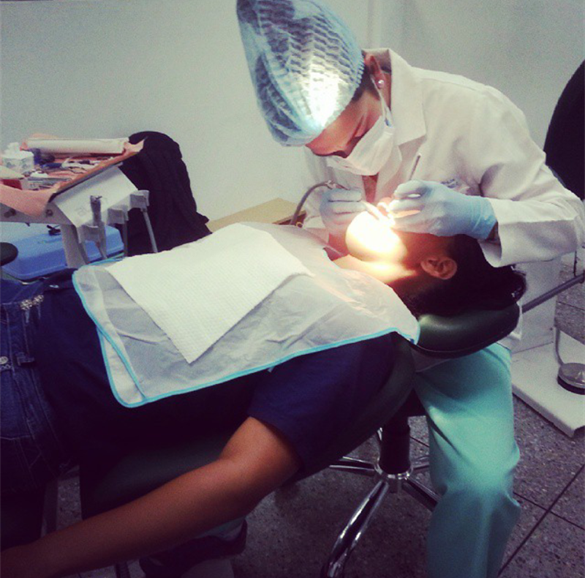Voice, Larynx and Vocal Strings
Greetings, friends steemians. Today I want to share with you the first of three publications related to voice and vocal cords.
The importance of the voice in daily communication is no secret to anyone. The characteristics of a person's voice depend mainly on sex, age, physical constitution and occupation.
The care and prevention of vocal health is of vital importance for all; moreover, for those people whose voice is used as a means of work. Such is the case of singers, social communicators, speakers, teachers, lecturers, receptionists, among others.

Source: Unpublished image captured with my flexible Olympus endoscope and edited with the Microsoft Power Point program
How is the voice produced?
The production of the voice is the most sophisticated of laryngeal functions. Coupling phonation, articulation and resonance allows us to talk and communicate.
This requires the intervention of various structures of the:
- Breathing: nose, lungs, bronchi and trachea.
- Phonation: vocal cords or vocal folds, larynx.
- Articulation: tongue, palate, teeth, lips.
- Resonators: paranasal sinuses, tonsils, adenoids, pharynx.
The process begins with the inhalation of air and the posterior glottic closure. An increase in subglottic pressure continues until the pressure exceeds the closing glottal force and air is allowed to escape between the vocal cords.
There must be adequate support of the breath to produce sufficient subglottic pressure; control of the laryngeal musculature to generate glottic closure and reach the appropriate length and tension in the vocal cords, together with the flexibility and vibratory capacity. Thus, in a summarized form, the voice is produced.
Is the larynx the same as the vocal cords?
No, the larynx is a complex and specialized organ that intervenes in the protection of the airway, control of respiration and in the production of sound and speech.
It is a muscular and cartilaginous structure, in the form of a tube, that joins the pharynx with the trachea, it is located between the cervical vertebrae C3 to C6. It is constituted by the hyoid bone and 3 odd cartilages: thyroid, cricoid and epiglottis and 3 pairs of cartilages: arytenoid, corniculate, cuneiform.
In the larynx we find the vocal cords or true vocal folds, and the ventricular bands (also known as false folds or vocal cords).

By derivative work: Alejandro Navarro López (User: Manchego) (talk) Larynx_external_en.svg: Olek Remesz (wiki-pl: Orem, commons: Orem) - Larynx_external_en.svg, CC BY-SA 2.5-2.0-1.0. Source
How are the vocal cords?
Vocal cords or vocal folds (most appropriate name). They are a pair of white, pearly structures, located in the larynx, whose vibration generates the sound we know as voice. These are formed by a layer of loose and flexible surface mucosa, which vibrates on the more rigid lower layers.

Source: Unpublished image captured with my flexible Olympus endoscope and edited with the Microsoft Power Point program


What methods do you use to examine the larynx and vocal cords?
At present, a series of diagnostic methods are available, which allow us to identify different pathologies that settle in the larynx and vocal cords.
Visualization of the larynx and vocal cords is essential for the evaluation of patients with voice disorders. These range from laryngoscopy with mirror, videolaryngoscopy, to video-ostroboscopy, which allows us to analyze the vibration of the vocal cords and detect so-called minimal structural lesions (nodules, polyps, vocal sulcus).


When should I evaluate my vocal cords?
Any alteration in the qualities of the voice (timbre, tone and intensity), known as hoarseness or hoarseness, is reason for you to make an evaluation by the otolaryngologist, phoniatrist or phonoaudiologist.
The dysphonia is a change in the voice that can appear suddenly, for example, in an intense vocal effort in a singer when wanting to reach a very high vocal note, which can produce a vocal hematoma or vocal bleeding.
It can also happen gradually, such is the case of nodules, polyps or tumors; in which the voice gradually changes; It can even be accompanied by a feeling of shortness of breath or dyspnea and also drowning with food.

Source: Unpublished image captured with my rigid endoscope Ecleris and edited with the Microsoft Power Point program
Similarly, dysphonia may develop when thyroid surgery is performed and the recurrent laryngeal nerve-the vagus nerve branch-that innervates the thyroarytenoid muscles (internal and external branches), interarytenoid (transverse and oblique) and the cricoaritenoids is injured. lateral and posterior.

center>Source: Unpublished image captured with my Samsung device
If I have a vocal cord injury, can I operate?
Yes, laryngeal and vocal cord surgeries are performed using a surgical microscope, because the structures are very small.
In the case of benign lesions such as polyps, nodules or cysts, which produce changes in the quality of the voice; A phonosurgery or phonomicrosurgery is performed and what is sought is to reestablish the vibration of the superficial lamina propria, and thus improve the patient's voice.
In the case of tumors, a biopsy (laryngeal microsurgery) should be performed first to determine the type of tumor. Later, according to the anatomopathological characteristics of the lesion, a new surgery will be performed, total or partial laryngectomy, with combined treatment with radiotherapy or chemotherapy depending on the case.
It is very important that the doctor perform a clinical examination of the characteristics of the voice. That is, educate the ear to determine if the patient's voice has the tone, timbre and intensity appropriate to their age, sex, physical constitution and occupation. In this way, even when the patient does not consult for alterations in his voice, these can be detected during the medical consultation and thus make an early diagnosis.
I'm Eadams, otolaryngologist. Until the next post.
References
Flint, P; Haughey, B; Lund, V; Niparko, J; Robbins, T; Thomas, R; Lesperance, M. (2015). Cummings Otolaryngology - Head and Neck Surgery. Sixth Edition. Elsevier Saunders Philadelphia.
Peñaranda, A; García, J; Pinzón, M. (2007). Manual of otolaryngology, head and neck. Amolca editions. Colombia.
Rosen, C; Simpson, B. (2013). Surgical Techniques in Laryngology. Germany. Edition in Spanish language. Amolca